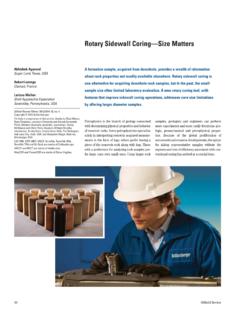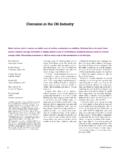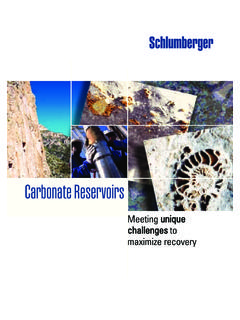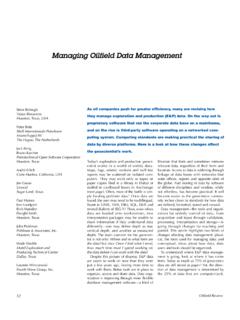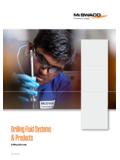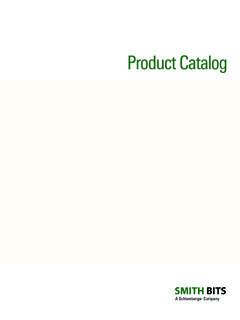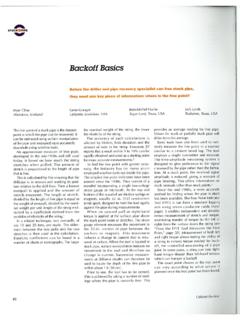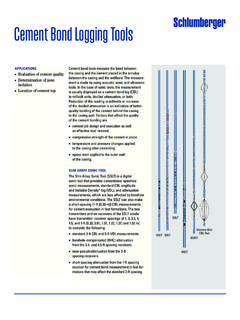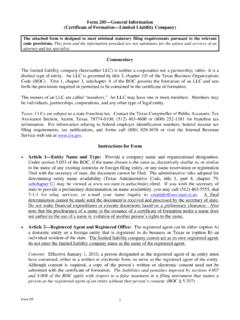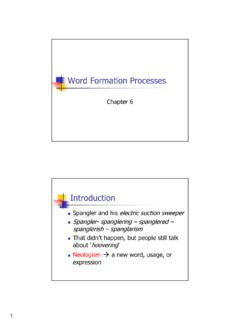Transcription of Fundamentals of Formation Testing - Oilfield Services
1 Fundamentals of Formation Testing Fundamentals ofFormation Testing Schlumberger225 Schlumberger DriveSugar Land, Texas 77478 Produced by Schlumberger Marketing Communications. 2006 Schlumberger. All rights part of this book may be reproduced, stored in a retrieval system, or transcribed in any form or by any means, electronic or mechanical, including photocopying and recording, without the prior written permission of the publisher. While the information presented herein is believed to be accurate, it is provided as is without express or implied asterisk (*) is used throughout this document to denote a mark of ..xiOverview ..1 Introduction ..1 Well Testing applications ..1 Formation pressure measurement ..1 Permeability and skin ..1 Formation fluid characterization ..2 Reservoir characterization ..2 Well Testing methods ..2 Openhole and cased hole, no completion ..2 Wireline Testing ..2 Production or injection test with completion string in place.
2 2 Well Testing objectives ..5 Exploration and appraisal well tests ..5 Development well tests ..5 Production and injection well tests ..6 Productivity well tests versus descriptive reservoir tests ..6 Goals of well test interpretations ..6 Reservoir pressure ..6 Steady-state radial flow in reservoirs ..8 Transient flow ..9 Dynamic Properties of Reservoir Rock ..13 Introduction ..13 Porosity ..13 Sandstones ..13 Carbonates ..14 Diagenesis and secondary porosity ..14 Natural fracturing ..14 Dissolution of limestone by leaching ..15 Dolomitization of limestone ..15 Diagenesis and porosity degradation ..15 Permeability ..15 Absolute permeability ..15 Mobility ..16 Effective permeabilities ..17 Surface tension and wettability ..17 Surface tension ..17 Wettability ..18 Capillary pressure and saturation profiles in the reservoir ..19 Capillary pressure and capillary rise ..19 Fundamentals of Formation Testing nContentsiiiSaturation profiles in reservoirs.
3 20 Irreducible water saturation ..21 Displacement capillary pressure and FWL ..22 Drainage and imbibition ..23 Capillary pressure and wettability ..23 Quantifying relative permeabilities ..24 References ..26 Dynamic Properties of Produced Fluids ..27 Components of hydrocarbons ..27 Classification of reservoir fluids ..28 Phase behavior of single-component systems ..30 Phase behavior of multiple-component systems ..30 Phase behavior of reservoir fluids ..32 Nonvolatile oil ..32 Volatile oil ..33 Condensate gas ..34 Wet gas ..35 Dry gas ..35 PVT properties ..36 Data sources ..36 Gas compressibility factor ..36 EOS: Basics of understanding ..36 Solution GOR and bubblepoint pressure ..38 FVFs ..38 Fluid densities ..39 Viscosities ..39 Compressibilities ..39 Modeling fluid behavior and PVT properties ..39 PVT correlations ..40 References ..40 Pressure Sensors Technology ..41 Introduction ..41 Mechanical pressure sensors ..41 Capacitance pressure sensors.
4 41 Strain pressure sensors ..42 Bonded wire sensors ..42 Thin film sensors ..42 Sapphire sensor ..42 Quartz pressure sensors ..44 Hewlett-Packard design ..44 Quartzdyne design ..44 Crystal Quartz Gauge ..45 Paroscientific design ..46 Quartztronics design ..46 Introduction to metrology of pressure transducers ..47 Static parameters ..47 Accuracy ..47 Resolution ..49 Stability ..50 Sensitivity ..50ivDynamic parameters ..51 Transient response during temperature variation ..51 Transient response during pressure variation ..52 Dynamic response during pressure and temperature shock ..52 Dynamic temperature correction on the pressure measurement ..53 Calibration and evaluation tests ..54 Well Testing Operations and Data Collection ..55 Openhole wireline Testing ..55 Pressure profiling ..55 Permeability anisotropy profiling ..55 Miniproduction tests ..55 Representative fluid sampling ..56 Modular reservoir power cartridge ..56 Modular reservoir hydraulics module.
5 56 Modular reservoir probe single module ..56 Modular reservoir sample chamber ..60 Modular reservoir packer dual module ..60 Flow-control module MRCF ..62 Modular reservoir packer module ..63 Modular reservoir pumpout module ..64 Modular reservoir fluid analyzer module ..64 Modular reservoir multisample module ..66 Cased hole wireline Testing ..67 Drillstem Testing ..67 Purpose of a DST ..67 Pressure-controlled tester valve ..68 Intelligent Remote Implementation System ..69 Universal Pressure Platform and UNIGAGE recorder ..72 DataLatch recorder ..74 DST sample chambers and carriers ..77 Other DST string configurations ..77 Simultaneous perforating and Testing ..78 TCP ..78 MWP ..78 Well tests for TCP and MWP operations ..80 Well tests in production and injection wells ..80 Control of wellbore effects while Testing ..81 Testing in pumping wells ..82 Permanent pressure measurements ..82 References ..84 Test Design Considerations ..85 Introduction.
6 85 New wells: DST or wireline Testing ? ..85 Production and injection wells ..86 Workover wells ..86 SRO versus downhole recording ..87 Pressure gauge metrology ..87 Fluid sampling options ..88 Operational constraints ..88 Interpretation requirements ..89 Fundamentals of Formation Testing nContentsvTest schedule and simulation ..89 Summary of test types ..89 References ..91 Reservoir Fluid Sampling ..93 Introduction ..93 Representativity of reservoir fluid samples ..93 Conditions for representativity ..93 Level of contamination ..94 Well conditioning ..94 The FPE service ..94 Wellsite sample validation and properties estimation ..94 Assessing bottomhole sample validity ..95 FPE analysis on bottomhole samples ..96 FPE analysis on separator samples ..98 Fluid sampling methods ..98 Wireline sampling ..98 Sampling during a DST well test ..99 Surface sampling ..99 Production well sampling ..99 DST and bottomhole sampling of oil reservoirs ..100 Preliminary considerations.
7 100 Sampling new wells and undepleted reservoirs ..100 Sampling depleted reservoirs ..100 Sampling high-volatility oil reservoirs ..101 Sampling near-critical fluids ..101 DST and bottomhole sampling of gas reservoirs ..101 Preliminary considerations ..101 Bottomhole versus surface sampling ..102 Sampling procedures ..102 Sampling new wells and undepleted reservoirs ..102 Sampling depleted reservoirs ..103 Surface sampling ..103 Wireline tester flowline fluid resistivity and optical properties ..103 Flowline resistivity ..103 Optical density ..105 Fluid coloration ..107 Scattering ..107 Gas detection ..109 Holdup indicators ..110 Wireline tester real-time fluid identification and contamination monitoring ..111 Introduction and summary of methods ..111 Oil-base filtrate contamination monitoring ..111 Direct sample methane detection: the LFA tool ..114In-situ determination of PVT properties ..116 Advanced wireline sampling techniques ..118 Dual-packer fluid sampling.
8 118 Pumpout module performance ..118 Minimum permeability requirement ..118 Pumpout time estimation ..118 Flowline and pump volumes ..119viControlled drawdown sampling ..120 Low-shock sampling ..121 Charged-chamber sampling ..122 Control of asphaltenes ..123 Heavy oil sampling ..123 Gas condensate sampling ..123 Water sampling ..123 Guard probe sampling and fluid flow modeling ..124 References ..124 Static Pressure Applications ..125 Determination of static reservoir pressure ..125 Wireline tester pretests ..125 Supercharging ..126 Static pressure from buildup tests ..127 Reservoir pressure from limit tests ..128 Drawdown mobility from wireline testers ..128 Drawdown mobility ..128 Radius of investigation for drawdown ..129 Drawdown permeability ..129 Buildup mobility ..130 Pressure-depth plots ..131 Reservoir fluid density from gradients ..131 Virgin reservoirs ..133 Developed reservoirs ..135 Pressure probes in tandem or triplex ..136 Pressure profiles in horizontal wells.
9 141 Effect of capillary pressure ..143 Applications of static pressure ..148 Depth datum of pressure ..148 Reservoir pressure in producing fields ..148 IPR, PI and AOF potential ..149 Selective Inflow Performance ..150 References ..151 Transient Testing Interpretation Principles ..153 Interpretation methodology ..153 IARF ..153 Line source solution to the diffusivity equation ..154 Wellbore storage and skin effects ..155 Wellbore storage effect ..155 Skin effect ..155 Combined WBS and skin effects ..156 Log-log plots and type-curve analysis ..157 Semilog approach ..157 Log-log approach ..157 Pressure derivative ..158 Attributes of the log-log plot ..158 Type-curve matching ..159 Succession of events detected during a well test ..160 Interpretation of drawdown tests ..162 Validity of interpretation ..162 Fundamentals of Formation Testing nContentsviiMiller, Dyes, Hutchinson plot and analysis ..162 Interpretation of buildup tests ..163 Drawdown versus buildup.
10 163 Horner plot and analysis ..163 Multirate superposition plot and analysis ..164 Changing WBS ..164 Convolution and deconvolution ..166 The convolution integral ..166 Rate normalization ..168 Deconvolution of afterflow rates ..171 Boundary conditions and reservoir flow models ..171 Inner boundary conditions ..171 Fractured well ..171 Partially completed well ..172 Horizontal well ..172 Reservoir flow models ..172 Dual-porosity reservoir ..172 Double-permeability reservoir ..173 Composite reservoir ..173 Outer boundary conditions ..173No-flow boundaries ..173 Constant pressure boundaries ..173 Mixed boundaries ..174 Numerical simulation of boundary conditions ..174 Specialized plots ..174 Interpretation of gas well tests ..175 Pseudopressure and pseudotime ..175 Pseudoskin ..175 References ..176 Advanced Applications of Transient Testing ..177 Buildup mobilities from wireline testers ..177 Spherical and radial derivatives ..177 Buildup mobilities.
